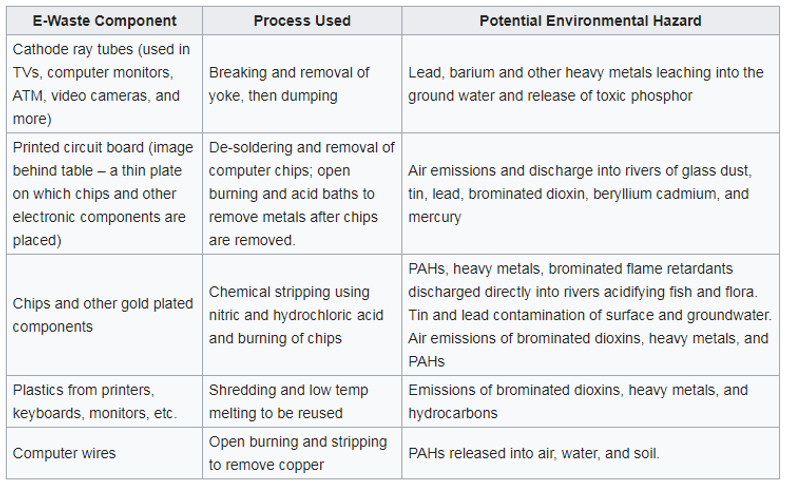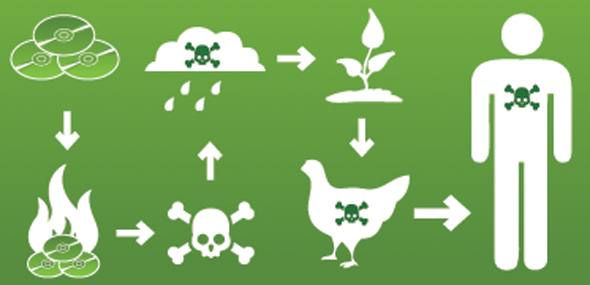
Electronic waste, or e-waste, is a term for electronic products that have become unwanted, non-working or obsolete, and have essentially reached the end of their useful life. Because technology advances at such a high rate, many electronic devices become “trash” after a few short years of use.
What is E-Waste?
Electronic Waste can be categorised into three main groups:
Large household appliances – e.g. Fridges and Washing Machines
IT and Telecom Items – e.g. PC’s, Laptops and Monitors
Consumer Equipment – e.g. Televisions
Electronics have become part of the ‘throw away’ culture in developed countries. The amount of electronic waste that is discarded each year is rapidly growing, with governments and recycling plants struggling to take on such a large amount of waste.

ENVIRONMENTAL IMPACT
The process of dismantling and disposing of electronic waste in developing countries has led to many environmental impacts.
Liquid and atmospheric releases end up in bodies of water, ground water, soil and air and therefore end up in land and sea animals – both domesticated and wild, in crops and in drinking water.



IMPACT ON HUMANS
The toxins and chemicals found in electrical and electronic waste can be very harmful to humans, in the recycling process if e-waste is not handled properly it can be deadly and cause short and long-term side effects.
Mercury
Mercury has a toxic effect on both human and environmental health. A small amount now exists in every household light-bulb, if these light-bulbs are crushed as part of the waste transfer process the elemental form of mercury is easily transferred into local environments. Once in landfill and combined with organics, anaerobic breakdown takes place leading to the production of highly toxic methyl-mercury. Mercury exposure contributes to brain and kidney damage.
Cadmium
Cadmium is cancer causing to humans. Within environmental systems it rapidly degrades soil health causing flow on effects to local ecosystems; it is also released to the atmosphere if burnt. It is associated with deficits in cognition, learning, behaviour and neuromotor skills in children. It has also been linked to kidney damage.
Brominated Flame Retardants
When e-waste is oxidized during smelting, bromine will be released. Bromine is a component in a group of fire retardant chemicals known as brominated flame retardants. It is associated with cognitive and developmental deficits. Studies have shown that bromine contributes to the disruption in the thyroid hormone balance, brain damage and cancer.
Beryllium
Inhalation of beryllium or beryllium-containing dust, mist or fume, may cause a chronic lung disorder called berylliosis in susceptible people.
Arsenic
Arsenic is classified as a carcinogen. In high doses, arsenic poisoning is lethal. Low levels of exposure cause negative impacts on skin, liver, nervous and respiratory systems.
Polyvinyl Chloride (PVC)
Hazardous chemical additives can leach when PVC components of electronic products are sent to landfill.
Lead
This toxic material has a well-documented history of negative health affects including brain damage, hence it’s removal from paints and petrol. The introduction of lead to the food chain and atmosphere (through lead combustion) are the primary causes of health problems in humans. Lead in the environment disrupts the natural functions of water and soil systems. Lead exposure can cause damage to the reproductive, blood and nervous systems.
Chlorine
Chlorine is a component of plastics used in cell phones, specifically polyvinyl chloride (PVC). PVC makes up about 30% of the cell phone. Exposure to improperly disposed chlorine causes tissue damage and the destruction of cell structure.
Sulphur
Sulphur found in lead-acid batteries and when released into the environment, can create sulphuric acid through sulphur dioxide. The affects of sulphur include liver damage, kidney damage, heart damage, eye and throat irritation.
There is also evidence od DNA breaks which can increase the likelihood of developing cancer.
---------------------------------------------------------------------------------------------------------------------
In 2011, IOP Science Daily conducted a study to discover the affects on e-waste chemical exposure on the human lung. Scientists took air samples from Taizhou of Zhejiang province in China – one of the largest dismantling areas in the country. Approximately 60,000 people work and dismantle over 2 million tons of e-waste annually.
The researchers found that e-waste pollution in the air, that workers in these e-waste dumps breath in constantly, cause inflammation and stress that lead to heart disease, DNA damage and possibly even cancer.
“After exposing the cultured lung cells to the organic-soluble and water-soluble constituents of the samples, the researchers tested for the level of Interleukin-8 (IL-8), a key mediator of inflammatory response, and Reactive Oxygen Species (ROS), chemically reactive molecules that can cause extensive damage in excess.
The samples were also tested for the expression of the p53 gene -- a tumour suppressor gene that produces a protein to help counteract cell damage. If there is evidence of this gene being expressed it can be seen as a marker that cell damage is taking place.
The results showed that the samples of pollutants caused significant increases in both IL-8 and ROS levels -- indicators of an inflammatory response and oxidative stress respectively. Significant increases were also observed in the levels of the p53 protein with the risk of organic-soluble pollutants being much higher than water-soluble pollutants.”

Get in Touch




